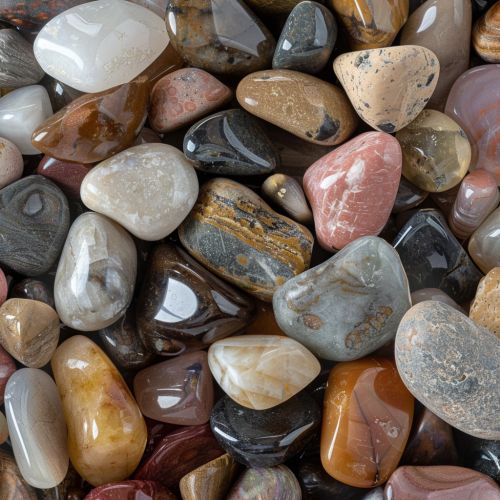Stone
Introduction
A stone is a solid, nonmetallic mineral matter of which rock is made, especially as a building material. Stones are typically classified by the process of their formation and their mineral content. They are a fundamental part of the Earth's crust and represent a significant component of other planetary bodies.
Formation of Stones
Stones are formed through a variety of geological processes. The Earth's crust is made up of a vast array of different types of stones, each formed under specific conditions and featuring unique characteristics. The formation of stones can be categorized into three main types: igneous, sedimentary, and metamorphic.
Igneous Stones
Igneous stones are formed when magma or lava cools and solidifies. This process can occur either beneath the Earth's crust (forming intrusive igneous stones) or on the Earth's surface (forming extrusive igneous stones). Examples of igneous stones include granite, basalt, and obsidian.
Sedimentary Stones
Sedimentary stones are formed from the accumulation of sediment. This sediment can be derived from pre-existing rocks or the skeletal remains of sea creatures, and are typically deposited in bodies of water. Over time, the layers of sediment are compressed and cemented together to form stones. Examples of sedimentary stones include limestone, sandstone, and shale.
Metamorphic Stones
Metamorphic stones are formed when pre-existing rocks are subjected to high temperatures and pressures, causing physical or chemical changes. This process, known as metamorphism, can alter the mineral composition and structure of the rock, resulting in a new type of stone. Examples of metamorphic stones include marble, slate, and quartzite.
Properties of Stones
The properties of stones are determined by their formation process and their mineral content. These properties include hardness, color, luster, and specific gravity, among others.
Hardness
The hardness of a stone is determined by its resistance to scratching. This property is typically measured on the Mohs scale, which ranges from 1 (softest) to 10 (hardest). For example, talc has a Mohs hardness of 1, while diamond, the hardest known natural substance, has a Mohs hardness of 10.
Color
The color of a stone can vary widely and is primarily determined by its mineral content. For example, the green color of emerald is due to the presence of chromium and vanadium, while the blue color of sapphire is due to the presence of iron and titanium.
Luster
The luster of a stone refers to the way it reflects light. Stones can exhibit a variety of lusters, including metallic, vitreous (glass-like), pearly, silky, greasy, and dull.
Specific Gravity
The specific gravity of a stone is a measure of its density. It is calculated by comparing the weight of the stone in air with its weight in water. Stones with a higher specific gravity are denser and typically heavier.
Uses of Stones
Stones have been used by humans for millions of years for a variety of purposes, including construction, tool making, and ornamentation.
Construction
Stones are widely used in construction due to their durability and strength. Different types of stones are used for different purposes, depending on their properties. For example, granite is often used for countertops due to its hardness and resistance to scratching, while limestone is commonly used in building construction due to its workability and abundance.
Tool Making
Early humans used stones to make tools and weapons. This period of human history, known as the Stone Age, is characterized by the use of stone tools. These tools were typically made by chipping or flaking stones to create sharp edges.
Ornamentation
Stones, particularly precious and semi-precious gemstones, have been used for ornamentation for thousands of years. These stones are often cut and polished to enhance their natural beauty and are used in jewelry, decorative objects, and works of art.


